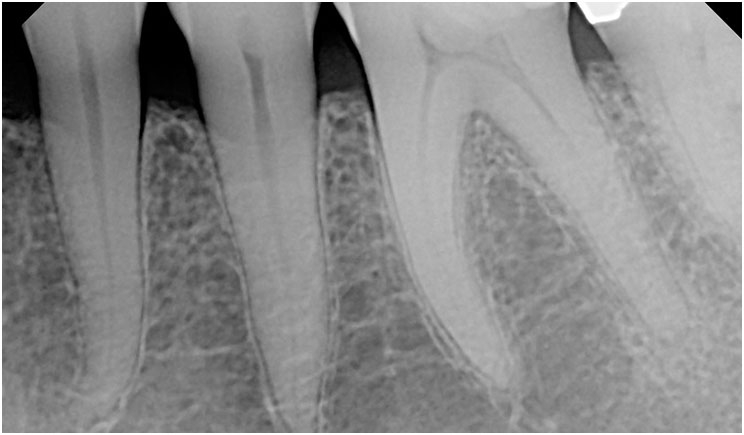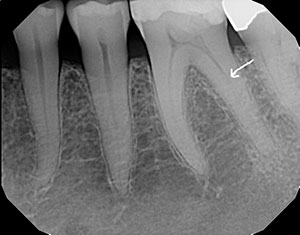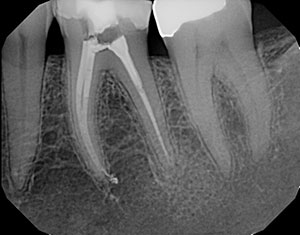
The patient came in with pain in tooth No. 19, which needed a root canal. Notice how narrow the canals are (see the figures). Check out the distal root. Can you see the canal split in the coronal third of the root? These canals have to be very carefully cleaned and shaped to prevent file separation. Also to prevent file separation, you should:
 |
 |
| Figure 2: The pre-operative radiograph of tooth No. 19 also revealed bifurcation (root split) in the distal, as indicated by the arrow. | Figure 3: The straight-on post-operative radiograph of tooth No. 19 shows the apparent joining of a distal canal and the mesial canals. |
 |
| Figure 4: The angled view in the post-operative radiograph of tooth No. 19 shows two distinct mesial canals and two distinct distal canals, all with separate portals of exits. |
- Provide adequate access with a straight line
- Establish a glide path with hand files, such as size 10 or 15 kfiles
- Follow up the glide path with .02 or .04 taper heat-treated rotary files
- Have Premier Dental’s RC-Prep and sodium hypochlorite in the canals while you’re instrumenting
- Use orifice openers
- Use heat-treated files, preferably a 0.4 taper with a minimum size of 25 at the apex
The case was completed in one visit by using Edge Endo EdgeFile X7 heat-treated files and Brasseler USA EndoSequence BC Sealer. Warm vertical condensation would not have been a good option in this case because it would have been virtually impossible to get the heat within 5 mm of the apex.
Dr. Short attended the Medical College of Georgia (MCG) School of Dentistry to attain a DMD degree in 1999. In 2002, he earned his postdoctorate degree in endodontics from Nova Southeastern University and then became a Diplomate of the American Board of Endodontics in 2009. Dr. Short is an expert consultant in endodontics to the Georgia Board of Dentistry and assistant clinical professor at the Dental College of Georgia in Augusta. His private practice, Apex Endodontics PC, is located in Smryna, Ga. He can be reached at dr.short@yahoo.com.
Related Articles
A Short Case Study: Hypertaurodont!
A Short Case Study: A Root Canal Trifecta
A Short Case Study: How Often Do You Look for the MB2?



